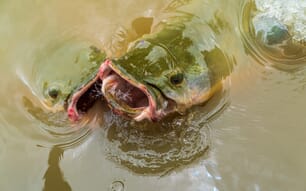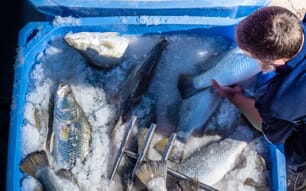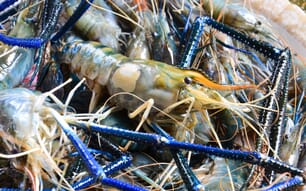
© C Greg Lutz
This time of year, farmed crawfish season is winding down and mature animals that weren’t harvested before season’s end are already down in their burrows – hovering above tiny pools of water in sealed chambers and dreaming of eventual re-emergence in the fall, when producers re-flood their ponds to kick off the next season. For the crawfish, it’s a pretty straightforward, uncomplicated plan. One that Mother Nature has perfected over the past 200 million years.
Most crawfish producers, on the other hand, have many more details to attend to before fall flooding than their crawfish do. Some are already cultivating rice in the fields that will produce next year’s crawfish harvests, in a crop-rotation strategy that helps keep Louisiana’s rice industry competitive during market downturns. Others will wait until August to plant their rice, which will serve strictly as a forage to support the food web that fuels crawfish aquaculture production. Still others will rely on natural vegetation to take hold and grow over the summer. Traps, boats, motors and pumps all have to be serviced and refurbished in the coming weeks.
However, apart from these year-to-year activities 2020 has been anything but typical for crawfish farmers. A survey of producers in April conducted by the LSU AgCenter indicated that decreased market demand resulting from Covid-19 impacts would ultimately cost growers approximately $500 per acre in lost revenues. Apply that figure across the most recent estimate of some 248,000 acres in Louisiana, and you have a tremendous economic impact.
Beginning in March, temporary loss of restaurant markets and consumer unease combined to hit producers hard during what would normally be the peak of the season. As alternative marketing strategies like drive-through and curbside pick-up emerged at restaurants and seafood shops, many producers complained of suspected market manipulation at various points in the value chain to keep prices and volume low. “Even without Covid-19 this is a huge problem every year for the farm-gate revenues for crawfish farming,” stated JB Hanks, a veteran producer and chairman of the Louisiana Farm Bureau Federation’s Crawfish Advisory Committee. By late April, many crawfish producers were forced to drain their fields and plant rice in an attempt to cut their losses.
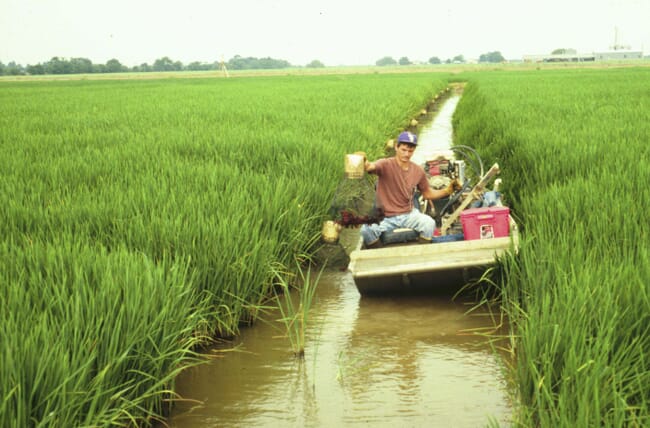
© C Greg Lutz
Dr Kurt Guidry, an economist with the AgCenter, pointed out that producers who hired foreign labour to bring in the catch are contractually obligated to pay those workers a guaranteed amount for a full season’s work. “It’s basically an expense some are having to pay without having a way to generate any income,” Guidry said. Mr Hanks, who farms some 1,200 acres of crawfish, also cited ongoing problems with labour costs. “The H-2A programme [a visa that permits foreign nationals entry to the United States to work as temporary agrigultural labourers] these past few years has worked well in bringing the labour to the US. However, the programme continues to push labour rates up each year and it is hard to understand the relationship between what is called the Adverse Effect Wage and the real wages on the farm. Everyone gets a raise because the H-2A guys can’t be paid more than anyone else on the farm.”
In crawfish aquaculture, management practices mimic annual hydrological and vegetative cycles in the crawfish’s habitat in the wild, and natural reproduction is relied on as a source of hatchlings each season. Newly established ponds (and rice fields to be used in crop rotations) are partially flooded and stocked in late spring with adult crawfish. Soon after stocking, crawfish burrow along the levees to reach wet soil below the surface, “plastering”, capping and sealing their burrows from the inside to conserve moisture over the months ahead. As summer progresses vegetation is established and the crawfish pass the time in the ground, oblivious to the day-to-day activities going on above them.
In their burrows, some female crawfish begin to lay eggs as early as late August. Production ponds and fields are flooded during the following weeks (late September through to late October). During this period many female crawfish leave their burrows and re-enter the ponds, often with eggs or newly hatched young attached. Once flooded, vegetation that grew during the summer begins a gradual breakdown process to support a natural food web that can yield between 350 and 900 lb of harvestable crawfish per acre (310 to 800kg per hectare) over the following seven to eight months. Depending on a number of factors, hatchlings will grow to market size in eight to sixteen weeks. Harvesting relies on the use of boats and baited traps, beginning as early as December and often continuing through to the following May or June. Peak harvests occur from March to May, and over half of all production expenses are associated with harvesting.
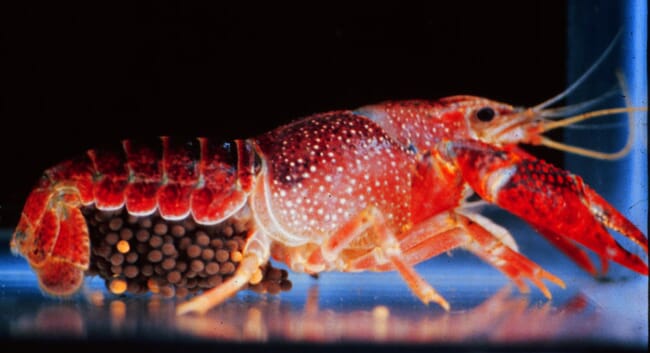
Lousiana has 1,600 crawfish farmers, producing 90 percent of the country's crawfish © C Greg Lutz
In some ways, crawfish aquaculture resembles the cultivation of certain vegetables and fruits more closely than raising fish or shrimp. Regular, frequent harvests are essential for profitability. Removal of larger crawfish frees up space and food resources for smaller animals. Ponds with excessively high populations often suffer from “stunting”, the density-related cessation of growth prior to the end of the harvest season. Once the season ends, the cycle is repeated as a new generation of adult crawfish burrow for the summer and vegetation is once again cultivated as forage for the next season’s crop.
Covid-19 impacts may continue to disrupt the value chain well into next season, but industry observers cite the expansion of crawfish aquaculture over the past decade as a reason for long-term optimism. In 2009 annual estimates indicated there were 1,119 crawfish aquaculture operations, totaling 173,078 acres (70,042 hectares). These ponds and fields produced 98,088,549 lb (44,492 tonnes) of crawfish with a farm-gate value of $115,746,943. By 2019, the LSU AgCenter reported 1,677 operations (up 66 percent) on 248,303 acres (100,484 hectares, up 43 percent), with harvests totaling 140,544,800 lb (63,750 tonnes, also up 43 percent) worth $252,360,640 (up 118 percent). All in all, a positive trajectory.
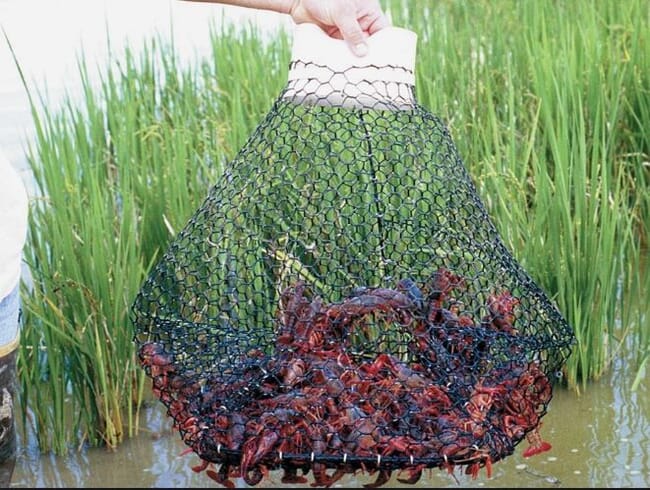
© C Greg Lutz
Nonetheless, the industry has some problems to tackle once things get “back to normal”. White spot syndrome virus (WSSV) was first detected in Louisiana in 2007 in crawfish from a number of farms and natural habitats. Outbreaks were scattered and sporadic over the next few years, but numerous reports of losses due to WSSV have been confirmed in recent seasons, especially during months when water temperatures fluctuate erratically. Although the disease has not significantly slowed the growth of the industry as a whole, when a pond breaks with WSSV, most harvestable crawfish die over a short period of time. This can result in catastrophic economic losses for individual producers.
JB Hanks stated: “I can’t step over white spot virus; in 2017 it kicked my harvest in the head, dropping the pounds harvested almost in half from the year before. Thank the good Lord our numbers have come way up from there but it is still out there and impacting the numbers. WSSV is out there. How it moves and how it acts in the off-season is so important.”
Industry stakeholders widely recognise the need for research on WSSV transmission in crawfish aquaculture. Major unknowns include: is the virus spreading? What causes a pond to break with WSSV? What are the long-term impacts to infected acreage? Are some crawfish more resistant than others? If so, is this resistance passed on to their offspring? The Louisiana Crawfish Promotion and Research Board has agreed to designate check-off funds to support a three-year, $125,000 project to investigate some of these issues, and the Louisiana Sea Grant college programme is also providing research funds to gather up-to-date data, based on field surveys.
Harvesting is the other immediate headache for most producers. JB Hanks summed it up succinctly: “… there must be a more effective way to harvest crawfish.” Dr Chandra Theegala, a professor in the AgCenter’s Department of Biological and Agricultural Engineering, was recently awarded a seed grant from USDA NIFA of approximately $200,000 to begin development of mechanical and automated harvesting for crawfish producers. Work will involve the design, construction and evaluation of traps that are more conducive to robotic handling, as well as a prototype robotic arm that can pick up and empty these traps with live crawfish, re-bait the traps and then reset them in a vertical position. Future work will involve design and evaluation of a trap-sighting device that transmits location coordinates to the robotic arm.
Crawfish aquaculture in rice fields and impounded ponds has been practised for seven decades in Louisiana. Along the way, major advances have included the development of hydraulic boats for harvesting, more efficient trap designs, manufactured baits and onboard grading devices. Most industry veterans view the current market situation as a bump in the road, with confidence that the industry will continue to grow in the decades to come.


